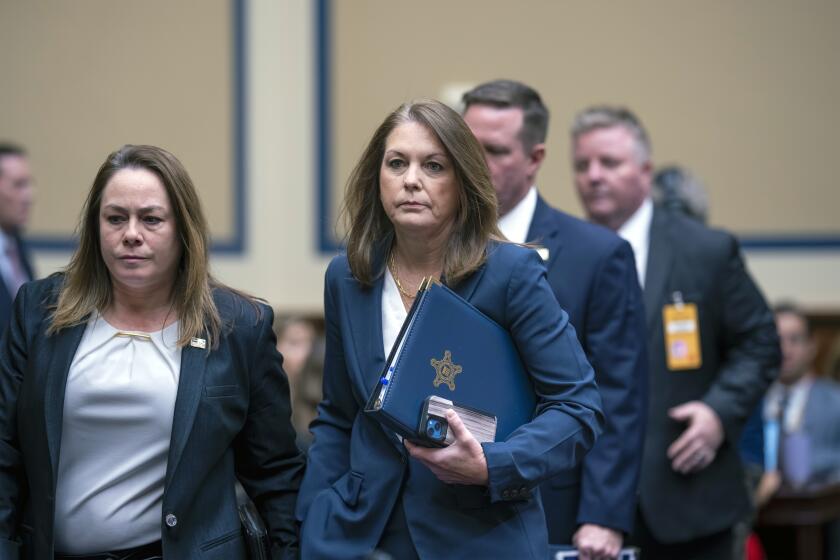New Wave of Mayhem : Juveniles Are Increasingly Committing Violent Crimes--and Experts Don’t Know Why or How Best to Stop Them
Four 15- and 16-year-olds were arrested Saturday in Lake Tahoe for what police call the “thrill shooting” of a 59-year-old man who was on a morning stroll when the youths, “looking for someone to scare,” pumped four bullets into him.
A 14-year-old checked into a Costa Mesa motel last Thursday with his girlfriend, also 14, after the boy allegedly murdered a 63-year-old retiree so he could steal his 1987 Dodge.
A 12-year-old and two other youths are charged with kidnaping a 57-year-old Pomona man and shooting him to death in August, after taking a joy ride in his Toyota while he pleaded for his life.
Two girls, ages 13 and 15, are charged with beating a 32-year-old woman to the ground on Crescent Heights Boulevard in West Hollywood, then trying to steal her purse and her Mercedes on July 31.
A 15-year-old from Thousand Oaks is accused of murdering the 16-year-old son of a Los Angeles police detective in a suburban back-yard attack in May.
Five Tustin youths, ages 15 to 17, have been charged in the May slaying of a 14-year-old who tried to reclaim the $2,500 stereo system his grandfather had given him.
*
That’s just a few weeks’ worth of juvenile crime stories noted in The Times. It is far from a complete list--and it is not just a Southern California phenomenon.
All around the country, tales of what might be called kiddie crime seem to take more and more space that was once filled with stories of more adult felons--that is, anyone over the age of 18.
It is not a media mirage: Statistics confirm that more horrendous crimes are being committed by increasingly younger children.
Although nonviolent crime committed by juveniles has dropped reassuringly in the past 10 years, the number of murders, robberies, rapes, kidnapings and other violent acts committed by juveniles has risen to new highs.
Between 1984 and 1992, the number of homicide suspects under the age of 15 increased by 50%, according to the FBI.
A recent analysis of data in California cities showed that homicide arrest rates for juveniles were increasing faster than for any other age group. Between 1980 and 1990, the homicide arrest rate for youngsters ages 10 through 17 increased 65%.
Even criminal experts do not agree on the causes of this increased mayhem--or on how to reverse the tide.
Poverty, crime-ridden neighborhoods, ineffective schools, parents addicted to drugs or alcohol are the traditional supposed causes of juvenile crime in the inner cities. But those causes do not explain the increasingly violent crimes committed by youths in more privileged areas, where people have more money and families are presumably a bit more intact.
“It used to be that you expected crime in some places and in other places you felt safe. Now it’s quite similar everywhere,” says Peter Greenwood, head of the Criminal Justice program at the Rand Corp. and a member of the state’s new juvenile justice task force.
“It’s increasingly clear that everyone’s kids are at risk--not just the kids of South-Central.”
While academics still debate the causes of juvenile crime and how to rehabilitate those who commit it, law enforcement officials and angry citizens are faced with more urgent immediate concerns: How should the legal system treat children who commit acts that, until very recently, were committed only by hard-core criminal adults?
*
Increasingly, the national urge is to remove the young felons from society for as long as possible, to mete out adult-style punishment for adult-style crimes.
Juvenile offenders have traditionally been tried in juvenile courts, where the emphasis is on rehabilitation rather than punishment and the court considers the “best interests of the minor” above all else.
That is changing rapidly. Many states have already reduced the age at which juveniles can be tried as adults.
Colorado, for example, recently passed a law that permits 14- to 17-year-olds to be tried as adults in cases of violent crime.
In January, California followed suit. It lowered the age at which juveniles can be tried as adults from 16 to 14, if accused of any of 29 violent crimes--a list to which the Legislature keeps adding.
Although youths under 18 still cannot receive the death penalty in California, those as young as 14 can now be sentenced to a lifetime in prison without possibility of parole.
Juvenile crime prosecutors have clamored for this.
“One function of a prosecutor is to protect the public and prevent law-abiding citizens from becoming victims,” says Laura Priver, deputy district attorney in charge of the Sylmar juvenile division. “The other concern is to rehabilitate juveniles who commit crimes. Both concerns have to be balanced.”
But if a juvenile commits a violent crime such as robbery with a hand gun, Priver says, then “there is nothing the juvenile justice system can offer him; we need to protect society by treating the offender as an adult.”
Tom Higgins, head of the District Attorney’s juvenile division for the southern part of Los Angeles County, says he tends to “agree with state legislators” that youths who commit serious crimes should not be given lenient treatment just because they are young.
“The victim is just as dead, even if a 15-year-old killed him. The family feels the loss exactly the same. The age of the perpetrator doesn’t change the nature of the crime.”
Or, increasingly, the nature of the punishment.
*
If there were a proven method of rehabilitating young offenders, it might be easier to argue against imprisonment. But after decades of trial and error, there is still no agreement on either the causes or the cures of juvenile crime.
Many experts point out that we are talking here about a very small percentage of the juvenile population, that the great majority of youngsters never commit a serious crime--although about half of all juveniles have at least one brush with the law in their teen-age years.
Studies show that 30% to 40% of all boys growing up in urban areas of the United States are arrested before their 18th birthday. Most of those will never be arrested again.
Higgins refers to an Orange County study that shows 70% of all juveniles who’ve had one arrest are not arrested again. About another 20% of those commit two or three crimes and do not get rearrested.
These figures seem to be true nationwide, the experts say--and there are interesting ramifications to the findings.
Says Higgins: “This means that up to 80% to 90% of all kids who are arrested and must appear in court say to themselves, ‘Whoa, I’m not going to go through that again.’ Not because they got any kind of rehabilitation from the court, but because the experience was life-changing for them.
“On the other hand, there is about 8% to 10% of kids who seem to be unreachable, at least once they’ve embarked upon serious crime.”
*
But Higgins and other experts have some less calming observations as well. Over the last two decades, the nature of juvenile crime has changed.
Whereas the prime source of illegal income for minors used to be stealing, now it is selling drugs.
And whereas illegal firearms were not easily available to 12-year-olds just a few years back, guns can now be obtained in any neighborhood by almost any youngster who has a yen for one.
And with juvenile crime increasingly violent and widespread--in urban, suburban, poor and middle-class neighborhoods--it seems possible that the low percentage of juvenile repeat offenders may rise.
There are those who say this whole emphasis on punishment and pragmatism is a doomed venture, almost guaranteed to cause us more trouble from our children in the future.
How many juvenile boot camps and detention facilities can we build, they ask?
How many young lives can we throw away because we believe that, after committing one major crime, a 14-year-old must be sent away for life?
“I deeply feel that there are very few 12- or 14-year-olds who are unsalvageable,” says Clyde Crohnkhite, former police chief of Santa Ana, deputy chief of the Los Angeles Police Department, director of the Center for the Administration of Justice at USC, and now chairman of the department of law enforcement and justice at Western Illinois University in Macomb, Ill.
“I have found again and again that adults who commit serious, habitual, violent crimes cannot be changed easily if at all. But young people, in varying degrees, can definitely be changed. They are in a learning mode.”
Unless they are sociopaths, Crohnkhite says, youngsters have the ability to rearrange their priorities and goals.
“Sociopaths--which constitute less than 1% of the population--don’t feel remorse, aren’t concerned if they hurt others and live only for today,” he says.
“I once did a study to find common denominators between children who commit crimes from well-to-do and from socially deprived homes,” Crohnkhite says.
“All children from both sets of homes felt they had no purpose in society, felt they weren’t important to their parents, had no strong parental supervision. They had low self-esteem.
“A recurring point made by both sets of juvenile offenders was that no one was home when they came home from school. No one to complain to, or to brag to about the day they’d had; no one to supervise their activities,” Crohnkhite says. “We heard this from kids of rich parents as well as poor parents.”
Crohnkhite recently returned from a crime conference in Geneva, which has a population of 400,000.
“They had three homicides last year, and very little juvenile crime. They attribute this to the fact that they are on a European system where most businesses are closed between 1 and 4 in the afternoon. Parents are indeed at home when the children get out of school, which seems to make a difference.”
Crohnkhite and others say kids “come home to TV sets, where they see things they can’t have and shouldn’t do. Combine this with the easy availability of handguns,” and teen-agers’ natural desire to stir up excitement, and we have a ready-made prescription for disaster.
*
Since no definitive answers have yet been found by sociologists, criminologists or educators, Crohnkhite favors a closer look at possible biochemical imbalances.
“Medical researchers have found that monkeys who are violent lack a chemical in the blood called seratonin. They have also found that children with low self-esteem have low levels of seratonin. Maybe we ought to work with the medical profession to help these kids. It would be better than what we do now.”
Forrest Tenant, M.D. and Ph.D., a public health specialist who heads a chain of 29 drug treatment facilities in California, has formulated “a whole bunch of theories” about preventing teen-age crime.
“We need new ideas, because the juvenile problem is immense. Science is going to have to dig in and come up with something that might help,” he says.
“Self-esteem is absolutely chemically based. One’s degree of motivation is also activated by biochemicals. I know of no one who has assayed these children’s nutritional histories, or measured the vitamins, minerals, amino acids and various nutrients in their bodies. It is these substances that allow the body to make seratonin, which gives a person a feeling of motivation and self-worth.”
“You test a successful athlete and he has very high degrees of seratonin because he eats properly. You test a gang member or a juvenile offender or a drug addict, and they have almost none. Problem kids eat tremendous amounts of carbohydrates--pasta, breads, cereals--when they should be having 50% protein. Where’s the beef, pork, veggies, eggs, cheese? It’s not in their diets. This is not conducive to good mental health.”
Vincent Schiraldi, founder and executive director of the Center on Juvenile and Criminal Justice, a public policy think tank in San Francisco, disagrees with current trends.
“The diagnosis is that we’ve been too lenient [with delinquents] thus far. We should try them like adults. But California has not been lenient. We have the highest juvenile incarceration rate in the country--twice the national average. Kids here serve more time for every category of crime than adults--except for murder one and two. We have epic numbers of kids locked up here and yet they continue to kill.
“We should start holding the system accountable. If two out of three Toyotas broke down within a year of coming out of the factory, Toyota would be out of business. But if two out of three kids coming out of juvenile institutions re-offend, we build bigger juvenile institutions.”
*
Schiraldi believes juvenile offenders can become solid citizens.
Abu Qadir Al-Amin, now director of the supportive living program at the Center, was once on Death Row. He says: “At 14 I was considered incorrigible; at 15 I served nine months at a boot camp near Sacramento,” after which he accidentally shot a man to death. “It was a petty theft. I had a gun, and a chain of events occurred that was not planned. I ended up on Death Row for two years and four months until the death penalty was declared unconstitutional.”
Al-Amin says our society does not treat its children with the concern and constructive assistance they deserve. And it does not treat all children equally. Some are considered potential criminals before they ever break the law, he says, just because of their race or economic standing.
Donald Fuller, director of the Delinquency Control Institute at USC, sums it up.
“Rehabilitation is pretty much out of favor as a concept for juvenile offenders. Now the theory is that they’ll learn if you lock them up for long enough. There are obvious problems with that. The criminal justice system has no resources to rehabilitate anyone. But all the existing theories have flaws. When it comes to juvenile crime, frankly nobody in the country and nobody in the world has the answer.”
More to Read
Sign up for Essential California
The most important California stories and recommendations in your inbox every morning.
You may occasionally receive promotional content from the Los Angeles Times.






